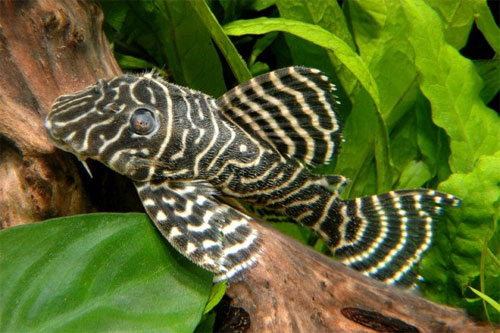It is not so dreadfully long ago that loricariid catfishes were regarded as the poor relations of the aquarium hobby, and were maintained and tolerated in the community aquarium solely on account of their often bizarre appearance and their useful characteristics. Back in those days only a few loricariid catfish enthusiasts deliberately sought out these fishes for their own sake, and as a result the number of species imported was comparatively small because of the limited demand.
In 1988 the opening-up of new collecting areas, above all in north-eastern Brazil, led to the discovery of a number of new loricariid catfishes that were very attractive in their coloration. When these were imported for the first time to Europe, Japan and the USA they created a huge sensation. A real boom followed, with increasingly larger numbers of aquarists becoming fascinated by these fishes. These newly imported catfishes included a large number of species which at that time couldn't even be identified at genus level. In addition in those days it was normal practice for every exporter to label such fishes with names that were the product of his own imagination. The result was an unholy state of chaos as regards nomenclature. The company Transfish in Planegg, Munich, was the first ornamental fish importer in Germany to bring in these fishes on a large scale and market them. The proprietor, Artur Werner, was a friend of Rainer Stawikowski, the editor of the aquarium magazine DATZ. Together they set about finding the best way to introduce these fishes to the aquarium hobby at large and to solve the problems regarding nomenclature. And it was thus that the L-number system came into being.
Every newly introduced loricariid catfish would be given a name consisting of the letter L (standing for the loricariid catfish family Loricariidae) and the next available number in an ascending sequence. Since December 1988 well over 400 L-number catfishes have been introduced to the aquarium hobby at large, and even more new species are still being discovered from time to time today. By far the majority of the L-number catfishes can be assigned to the former subfamily Ancistrinae, which according to Armbruster (2004) is currently to be regarded as the tribe Ancistrini of the subfamily Hypostominae. These catfishes are characterised by the presence of spinous growths known as odontodes on a moveable struc-ture posterior to the operculum, a feature lacking in all other loricariid catfish groups. The majority of the remainder of the species are assigned to the tribe Hypostomini. Only a few members of other loricariid catfish groups have to date been assigned an L-number.

As an alternative to the L-number system devised by DATZ the German aquarium magazine Das Aquarium came up with its own system code numbers known as LDA-numbers (standing for "Loricariidae Das Aquarium"). Not surprisingly opinions differed as to whether such a second system was a good idea or not, and for this reason the LDA-number have been the subject of much argument. But the fact nevertheless remains that this alternative system does exist and is in use, and so we just have to live with the situation. Since the magazine Das Aquarium went out of production in December 2005 no further new LDA-numbers have been published and for this reason the last LDA-number to be published was LDA 102.
In the meantime the L-number system has been adopted by practically all the exporters in South America and thus nowadays in the vast majority of cases exporters, wholesalers, pet retailers, and aquarists encounter the same designation applied consistently to all the various loricariids. But even today it is still pretty much a matter of luck what L-number catfish one receives from certain exporters even if a particular L-number has been ordered. By now a whole series of L-number catfish catalogues have been published, but unfortunately these sometimes portray different species as particular L-numbers and have thus led to even greater confusion. And in addition the exporters are not always as precise as they might be and assign unidentified species to similar L-numbers in order to make them more readily saleable. Thus despite the invention of L-numbers it appears that even to-day we are still not all speaking one and the same language. But at least the situation is rather better than in the past.



